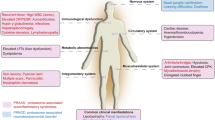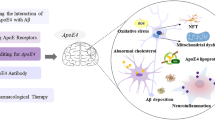Abstract
Apolipoprotein E (apoE) is a multifunctional circulating 34-kDa protein, whose gene encodes single-nucleotide polymorphisms linked to several neurodegenerative diseases. Here, we evaluate whether synthetic RNA/DNA oligonucleotides (chimeraplasts) can convert a dysfunctional gene, APOE4 (C → T, Cys112Arg), a risk factor for Alzheimer’s disease and other neurological disorders, into wild-type APOE3. In preliminary experiments, we treated recombinant Chinese hamster ovary (CHO) cells stably secreting apoE4 and lymphocytes from a patient homozygous for the ɛ4 allele with a 68-mer apoE4-to-apoE3 chimeraplast, complexed to the cationic delivery reagent, polyethyleneimine. Genotypes were analyzed after 48 h by routine polymerase chain reaction-restriction fragment length polymorphism (PCR-RFLP) and by genomic sequencing. Clear conversions of APOE4 to APOE3 were detected using either technique, although high concentrations of chimeraplast were needed (≥800 nM). Spiking experiments of PCR reactions or CHO-K1 cells with the chimeraplast confirmed that the repair was not artifactual. However, when treated recombinant CHO cells were passaged for 10 d and then subcloned, no conversion could be detected when >90 clones were analyzed by locus-specific PCR-RFLP. We conclude that the apparent efficient repair of the APOE4 gene in CHO cells or lymphocytes 48 h post-treatment is unstable, possibly because the high levels of chimeraplast and polyethyleneimine that were needed to induce nucleotide substitution are cytotoxic.
Similar content being viewed by others
References
Albuquerque-Silva J., Vassart G., Lavinha J., and Abramowicz M. J. (2001) Chimeraplasty validation. Nat. Biotechnol. 19, 1011.
Alexeev V., Igoucheva O., Domashenko A., Cotsarelis G., and Yoon K. (2000) Localized in vivo genotypic and phenotypic correction of the albino mutation in skin by RNA-DNA oligonucleotide. Nat. Biotechnol. 18, 43–47.
Beffert U., Danik M., Krzywkowski P., Ramassamy C., Berrada F., and Poirier J. (1998) The neurobiology of apolipoproteins and their receptors in the CNS and Alzheimer’s disease. Brain Res. Rev. 27, 119–142.
Beffert U., Stolt P. C., and Herz J. (2004) Functions of lipoprotein receptors in neurons. J. Lipid Res. 45, 403–409.
Bertoni C. and Rando T. A. (2002) Dystrophin gene repair in mdx muscle precursor cells in vitro and in vivo mediated by RNA-DNA chimeric oligonucleotides. Hum. Gene Ther. 13, 707–718.
Cole-Strauss A., Yoon K., Xiang Y., Byrne B. C., Rice M. C., Gryn J., et al. (1996) Correction of the mutation responsible for sickle cell anemia by an RNA-DNA oligonucleotide. Science 273, 1386–1389.
DeKroon R. M. and Armati P. J. (2001) The endosomal trafficking of apolipoprotein E3 and E4 in cultured human brain neurons and astrocytes. Neurobiol. Dis. 8, 78–89.
Fischer D., Bieber T., Li Y., Elsasser H. P., and Kissel T. (1999) A novel non-viral vector for DNA delivery based on low molecular weight, branched polyethylenimine: effect of molecular weight on transfection efficiency and cytotoxicity. Pharmacol. Res. 16, 1273–1279.
Gamper H. B., Parekh H., Rice M. C., Bruner M., Youkey H., and Kmiec E. B. (2000) The DNA strand of chimeric RNA/DNA oligonucleotides can direct gene repair/conversion activity in mammalian and plant cell-free extracts. Nucleic Acids Res. 28, 4332–4339.
Gasparini L., Racchi M., Binetti G., Trabucchi M., Solerte S. B., Alkon D., et al. (1998) Peripheral markers in testing pathophysiological hypotheses and diagnosing Alzheimer’s disease. FASEB J. 12, 17–34.
Gong J. S., Kobayashi M., Hayashi H., Zou K., Sawamura N., Fujita S. C., et al. (2002) Apolipoprotein E (ApoE) isoform-dependent lipid release from astrocytes prepared from human ApoE3 and ApoE4 knock-in mice. J. Biol. Chem. 277, 29,919–29,926.
Graham I. R., Manzano A., Tagalakis A. D., Mohri Z., Sperber G., Hill V., et al. (2001) Gene repair validation. Nat. Biotechnol. 19, 507–508.
Hixson J. E. and Vernier D. T. (1990) Restriction isotyping of human apolipoprotein E by gene amplification and cleavage with HhaI. J. Lipid Res. 31, 545–548.
Kay A. D., Day S. P., Kerr M., Nicoll J. A., Packard C. J., and Caslake M. J. (2003) Remodeling of cerebrospinal fluid lipoprotein particles after human traumatic brain injury. J. Neurotrauma 20, 717–723.
Koch S., Donarski N., Goetze K., Kreckel M., Stuerenburg H. J., Buhmann C., et al. (2001) Characterization of four lipoprotein classes in human cerebrospinal fluid. J. Lipid Res. 42, 1143–1151.
Kren B. T., Bandyopadhyay P., and Steer C. J. (1998) In vivo site-directed mutagenesis of the factor IX gene by chimeric RNA/DNA oligonucleotides. Nat. Med. 4, 285–290.
Liu L., Rice M. C., and Kmiec E. B. (2001) In vivo gene repair of point and frameshift mutations directed by chimeric RNA/DNA oligonucleotides and modified single-stranded oligonucleotides. Nucleic Acids Res. 29, 4238–4250.
Mahley R. W. and Ji Z. S. (1999) Remnant lipoprotein metabolism: key pathways involving cell-surface heparan sulfate proteoglycans and apolipoprotein E. J. Lipid Res. 40, 1–16.
Mahley R. W. and Rall S. C. Jr. (2000) Apolipoprotein E: far more than a lipid transport protein. Annu. Rev. Genomics Hum. Genet. 1, 507–537.
Majumdar A., Puri N., Cuenoud B., Natt F., Martin P., Khorlin A., et al. (2003) Cell cycle modulation of gene targeting by a triple helix-forming oligonucleotide. J. Biol. Chem. 278, 11,072–11,077.
Manzano A., Mohri Z., Sperber G., Ogris M., Graham I., Dickson G., et al. (2003) Failure to generate atheroprotective apolipoprotein AI phenotypes using synthetic RNA/DNA oligonucleotides (chimeraplasts). J. Gene Med. 5, 795–802.
Negri C., Chiesa R., and Ricott G. C. (1991) Factor(s) required by EBV transformed lymphocytes to grow under limiting dilution conditions. Cytotechnology 7, 173–178.
Nickerson H. D. and Colledge W. H. (2003) A comparison of gene repair strategies in cell culture using a lacZ reporter system. Gene Ther. 10, 1584–1591.
Ogris M. and Wagner E. (2002) Tumor-targeted gene transfer with DNA polyplexes. Somat. Cell Mol. Genet. 27, 85–95.
Olsen P. A., McKeen C., and Strauss S. (2003) Branched oligonucleotides induce in vivo gene conversion of a mutated EGFP reporter. Gene Ther. 10, 1830–1840.
Rice M. C., Czymmek K., and Kmiec E. B. (2001) The potential of nucleic acid repair in functional genomics. Nat. Biotechnol. 19, 321–326.
Richardson P. D., Kren B. T., and Steer C. J. (2002) Gene repair in the new age of gene therapy. Hepatology 35, 512–518.
Sacre S. M., Stannard A. K., and Owen J. S. (2003) Apolipoprotein E (apoE) isoforms differentially induce nitric oxide production in endothelial cells. FEBS Lett. 540, 181–187.
Saunders A. M. (2000) Apolipoprotein E and Alzheimer disease: an update on genetic and functional analyses. J. Neuropathol. Exp. Neurol. 59, 751–758.
Shi N., Zhang Y., Zhu C., Boado R. J., and Pardridge W. M. (2001) Brain-specific expression of an exogenous gene after i.v. administration. Proc. Natl. Acad. Sci. U. S. A. 98, 12,754–12,759.
Strittmatter W.J. and Bova Hill C. (2002) Molecular biology of apolipoprotein E. Curr. Opin. Lipidol. 13, 119–123.
Tagalakis A. D., Graham I. R., Riddell D. R., Dickson J. G., and Owen J. S. (2001) Gene correction of the apolipoprotein (apo) E2 phenotype to wild-type apoE3 by in situ chimeraplasty. J. Biol. Chem. 276, 13,226–13,230.
Taubes G. (2002) The strange case of chimeraplasty. Science 298, 2116–2120.
Thomas K. R. and Capecchi M. R. (1997) Recombinant DNA technique and sickle cell anemia research. Science 275, 1404,1405.
Thorpe P., Stevenson B. J., and Porteous D. J. (2002a) Functional correction of episomal mutations with short DNA fragments and RNA-DNA oligonucleotides. J. Gene Med. 4, 195–204.
Thorpe P., Stevenson B. J., and Porteous D. J. (2002b) Optimising gene repair strategies in cell culture. Gene Ther. 9, 700–702.
Tran N. D., Liu X., Yan Z., Abbote D., Jiang Q., Kmiec E. B., et al. (2003) Efficiency of chimeraplast gene targeting by direct nuclear injection using a GFP recovery assay. Mol. Ther. 7, 248–253.
Van der Steege G., Schuilenga-Hut P. H., Buys C. H., Scheffer H., Pas H. H., and Jonkman M. F. (2001) Persistent failures in gene repair. Nat. Biotechnol. 19: 305–306.
Wu Y. Y., Delgado R., Costello R., Sunderland T., Dukoff R., and Csako G. (2000) Quantitative assessment of apolipoprotein E genotypes by image analysis of PCR-RFLP fragments. Clin. Chim. Acta 293, 213–221.
Xu P. T., Schmechel D., Rothrock-Christian T., Burkhart D. S., Qiu H. L., Popko B., et al. (1996) Human apolipoprotein E2, E3 and E4 isoform-specific transgenic mice: human-like pattern of glial and neuronal immunoreactivity in central nervous system not observed in wild-type mice. Neurobiol. Dis. 3, 229–245.
Yoon K., Igoucheva O., and Alexeev V. (2002) Expectations and reality in gene repair. Nat. Biotechnol. 20, 1197–1198.
Zhang Z., Eriksson M., Falk G., Graff C., Presnell S. C., Read M. S, et al. (1998) Failure to achieve gene conversion with chimeric circular oligonucleotides: potentially misleading PCR artifacts observed. Antisense Nucleic Acid Drug Dev. 8, 531–536.
Author information
Authors and Affiliations
Corresponding author
Rights and permissions
About this article
Cite this article
Tagalakis, A.D., Dickson, J.G., Owen, J.S. et al. Correction of the neuropathogenic human apolipoprotein E4 (APOE4) gene to APOE3 in vitro using synthetic RNA/DNA oligonucleotides (chimeraplasts). J Mol Neurosci 25, 95–103 (2005). https://doi.org/10.1385/JMN:25:1:095
Received:
Accepted:
Issue Date:
DOI: https://doi.org/10.1385/JMN:25:1:095




